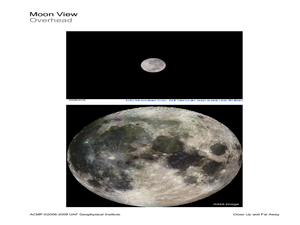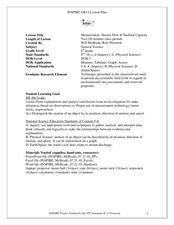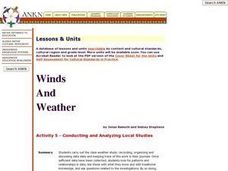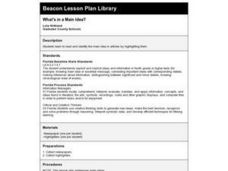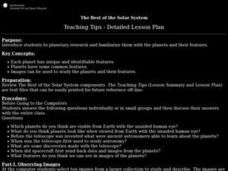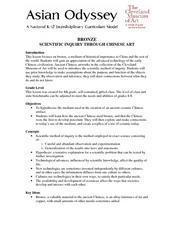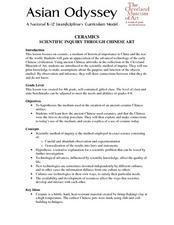Curated OER
Density of a Sinker
Eighth graders determine the density of a sinker by first finding the mass and then the volume using a graduated cylinder. Students must write the procedure they use to find the volume of the sinker then apply their data to follow-up...
Curated OER
Building Materials
Fifth graders are presented with three rocks and a variety of tools and are asked to investigate the properties of the rocks to see which rock is best for building tables and benches for a museum picnic area.
Curated OER
Exploring the Properties of Matter in the Preschool
Students study the properties of the physical and natural world. In this properties of the physical and natural world instructional activity, preschool students work at discovery tables to see how simple machines work, what happens when...
Curated OER
Snowfall
Students examine the differences between snow and rain. In this precipitation lesson, students measure one inch of rain and snow to calculate the amount of liquid water. Students use a snowfall "conversion" chart to measure how much...
Curated OER
Oral History
Students interview a Native Elder to learn about oral history and cold weather. In this weather instructional activity, students ask an Elder about the coldest day they remember in their community and complete two worksheets for the topic.
Curated OER
Permafrost
Students use a thermometer to analyze soil temperature data to determine which soil sample is normal, and which one is permafrost. In this permafrost lesson plan, students participate in a hands on activity where they identify the active...
Curated OER
Close Up and Far Away
Students use magnifiers and telescopes to view things close up. In this magnifiers and telescopes lesson plan, students use the tools to identify things that are close and far away. Students tell details of things they can see closer.
Curated OER
Visual Learning: Gone Fishing
Students complete visual learning activities using a photograph of a fisherman. In this photograph analysis instructional activity, students analyze the photograph and the facts within the picture. Students read a quote and caption for...
Curated OER
Measurement: Stream Flow & Stadium Capacity
Eighth graders study the scientific fields and how information can be monitored and recorded. In this scientific inquiry lesson students view a PowerPoint presentation and complete a hands on activity.
Curated OER
The Best of the Solar System (Grades 4-7)
Learners explore planetary research and become familiar with the planets and their characteristics. They compare and contrasts planets and moons.
Curated OER
Conducting and Analyzing Local Studies
Students carry out the class weather study: recording, organizing and discussing data daily and keeping track of this work in their journals. They look for patterns and relationships in data, link these with what they know and with...
Curated OER
What's in a Main Idea?
Second graders read newspaper articles. In this language arts lesson, 2nd graders identify the main ideas found in the articles by highlighting them. The entire class selects one interesting article from the sports section to discuss.
Curated OER
The Best of the Solar System (Grades 6-8)
Students are introduced to planetary research and become familiar with the planets and their features. They view images of the planets, and fill in an information chart which is imbedded in this plan.
Curated OER
Bronze: Scientific Inquiry through Chinese Art
Students examine the use of bronze and porcelain in Chinese art and commerce through in-class activities, role play events, and small-group discussions in this exciting Social Studies/Arts lesson.
Curated OER
Paper: Scientific Inquiry Through Chinese Art
Students create replicas of Chinese hanging scrolls in an attempt to understand the technology behind the creation and use of paper in Ancient China. This three-day lesson includes enrichment ideas.
Curated OER
Ceramics Scientific Inquiry Through Chinese Art
Fourth graders explore, examine and study ceramics, a medium of historical importance to China. They review the advanced technology of the early Chinese civilization and are introduced to the scientific method of inquiry and make...
Curated OER
Animal Trackers
Learners use space technology to monitor migratory species, map their movements, and gather data about their habitats and possible responses to climatic shifts.
Curated OER
Why Do We Have Thanksgiving?
Pupils investigate the change in the Thanksgiving holiday over time. They research the Native Americans and Pilgrims to find out how their relationship affected the holiday. They create a PowerPoint presentation using digital cameras...
Curated OER
Reduce, Reuse, Recycle
Fourth graders discover the differences between: reduce, reuse, and recycle by performing hands on examinations. They list what would happen to the soil if we allowed the earth to wash away and briefly discuss the meaning of erosion.
Curated OER
The Nitrogen Cycle
Fifth graders investigate the nitrogen cycle and examine the concepts of decomposition and nitrification. Students participate in a class discussion about the creation of waste and ammonia compounds, then using nitrogen cycle cut-outs...
Curated OER
Marshland Wonders
Students review the characteristics of wetlands and list their benefits. After viewing short videos, they identify the organims that make their home in wetlands and how they have adapted. They compare and contrast the characteristics...
Curated OER
The Ups and Downs of Weight and Mass
Young scholars explore the concept of mass, and how it differs from weight. They also calculate their weight change as they ride up and down on an elevator. They record the changes in their weight as the elevator moves
graph the...
Curated OER
Producing Heat
Students listen to "Heat Wave" by Helen Ketterman and discuss the story by creating a word web with heat as the main topic. They break into groups and conduct an experiment using a thermometer to record the temperature of melting ice...
Curated OER
Pattern
Students describe examples of the relationship between structure and function in living systems, particularly with regard to specialized tissues and organs. They describe examples of biological diversity and adaptation of organisms with...
Other popular searches
- Inference and Observation
- Observation Inference Lab
- Observation Inference Demo
- Inference Observation
- Observation Inference Science








